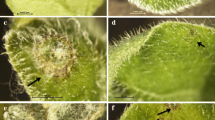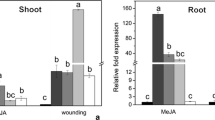Abstract
Pathogenesis-related proteins (PR), including β-1,3-glucanases may provide the first line of defense against fungal pathogens. Many PR proteins are activated by salicylic acid (SA), which acts as an endogenous signal. We have previously isolated seven members of the β-1,3-glucanase gene family in barley (Hordeum vulgare). In this paper, we characterized the β-1,3-glucanase isoenzyme GIII for SA-responsive elements in the GIII gene promoter. A series of deletion mutations of the promoter were fused to the reporter gene beta-glucuronidase (gus). The GUS activity was analyzed in rice calli (Oryza sativa L.) in response to SA. A deletion fragment between −362 and +106 bp showed the highest level of GUS activity in these assays. This promoter fused with gus was further introduced into rice plants for stable transformation. Histochemical staining and fluorometric quantitation of GUS activity in leaves of transgenic plants revealed prominent GUS expression after SA induction. RNA analysis by Northern blotting confirmed the importance of this region, indicating that cis-acting elements required for SA-inducible expression exist within 362 bp upstream from the transcriptional start site.







Similar content being viewed by others
References
Buchel AS, Molenkamp R, Bol JF, Linthorst HJ (1996) The PR-1a promoter contains a number of elements that bind GT-1-like nuclear factors with different affinity. Plant Mol Biol 30:493–504
Buttner M, Singh KB (1997) Arabidopsis thaliana ethylene-responsive element binding protein (AtEBP), an ethylene-inducible, GCC box DNA-binding protein interacts with an ocs element binding protein. Proc Natl Acad Sci USA 94:5961–5966
Cheong YH, Kim1 CY, Chun HJ, Moon BC, Park HC, Kim JK, Lee S, Han C, Lee SY, Cho MJ (2000) Molecular cloning of a soybean class III β-1,3-glucanase gene that is regulated both developmentally and in response to pathogen infection. Plant Sci 154:71–81
Dempsey DA, Shah J, Klessig DF (1999) Salicylic acid and disease resistance in plants. Crit Rev Plant Sci 18:547–575
Despres C, Subramaniam R, Matton DP, Brisson N (1995) The activation of the potato PR-10a gene requires the phosphorylation of the nuclear factor PBF-1. Plant Cell 5:589–598
Fukuda Y, Shinshi H (1994) Characterization of a novel cis-acting element that is responsive to a fungal elicitor in the promoter of a tobacco class I chitinase gene. Plant Mol Biol 24:485–493
Goldsbrough AP, Albrecht H, Stratford R (1993) Salicylic acid-inducible binding of a tobacco nuclear protein to a 10 bp sequence, which is highly conserved amongst stress-inducible genes. Plant J 4:563–571
Gruner R, Strompen G, Pfitzner AJ, Pfitzner UM (2003) Salicylic acid and the hypersensitive response initiate distinct signal transduction pathways in tobacco that converge on the as-1-like element of the PR-1a promoter. Eur J Biochem 270:4876–4886
Henning J, Dewey RE, Cutt JR, Klessig DF (1993) Pathogen, salicylic acid and developmental dependent expression of β-1,3-glucanase/GUS gene fusion in transgenic tobacco plants. Plant J 4:481–493
Hoekema A, Hirsch PR, Hooykaas PJJ, Schilperoort RA (1983) A binary plant vector strategy based on separation of vir- and T-region of Agrobacterium tumefaciens Ti-plasmid. Nature 303:179–180
Höfgen R, Willmitzer L (1988) Storage of competent cells for Agrobacterium transformation. Nucleic Acids Res 16:9877
Jefferson RA, Kavanagh TA, Bevan MW (1987) GUS fusions: beta-glucuronidase as a sensitive and versatile gene fusion marker in higher plants. EMBO J 6:3901–3907
Lam E, Chua NH (1990) GT-1binding site confers light responsive expression in transgenic tobacco. Science 248:471–474
Lebel E, Heifetz P, Thorne L, Uknes S, Ryals J, Ward E (1998) Functional analysis of regulatory sequences controlling PR-1 gene expression in Arabidopsis. Plant J 16:223–233
Linthorst HJM (1991) Pathogenesis-related proteins of plants. Crit Rev Plant Sci 10:123–150
Malamy J, Carr JP, Klessig DF, Raskin I (1990) Salicylic acid: a likely endogenous signal in the resistance response of tobacco to viral infection. Science 250:1002–1004
Mazarei M, Puthoff DP, Hart JK, Rodermel SR, Baum TJ (2002) Identification and characterization of a soybean ethylene-responsive element-binding protein gene whose mRNA expression changes during soybean cyst nematode infection. Mol Plant Microbe Interact 15:577–586
Niggeweg R, Thurow C, Kegler C, Gatz C (2000) Tobacco transcription factor TGA2.2 is the main component of as-1-binding factor ASF-1 and is involved in salicylic acid- and auxin-inducible expression of as-1-containing target promoters. J Biol Chem 275:19897–19905
Payne G, Ward E, Gaffney T, Goy PA, Moyer M, Harper A, Meins F, Ryals J Jr (1990) Evidence for a third structural class of β-1,3-glucanase in tobacco. Plant Mol Biol 15:797–808
Pieterse CM, van Loon LC (1999) Salicylic acid-independent plant defence pathways. Trends Plant Sci 4:52–58
Qin XF, Holuigue L, Horvath DM, Chua NH (1994) Immediate early transcription activation by salicylic acid via the cauliflower mosaic virus as-1 element. Plant Cell 6:863–874
Raventos D, Jensen AB, Rask MB, Casacuberta JM, Mundy J, San Segundo B (1995) A 20 bp cis-acting element is both necessary and sufficient to mediate elicitor response of a maize PRms gene. Plant J 7:147–155
Roulin S, Xu P, Brown AHD, Fincher GB (1997) Expression of specific (1,3)-β-glucanase genes in leaves of near-isogenic resistant and susceptible barley lines infected with the leaf scald fungus (Rhynchosporium secalis). Physiol Mol Plant Pathol 50:245–261
Rushton PJ, Torres JT, Parniske M, Wernert P, Hahlbrock K, Somssich IE (1996) Interaction of elicitor-induced DNA-binding proteins with elicitor response elements in the promoters of parsley PR1 genes. EMBO J 15:5690–5700
Shah J, Klessig DF (1996) Identification of a salicylic acid-responsive element in the promoter of the tobacco pathogenesis-related beta-1,3-glucanase gene, PR-2d. Plant J 10:1089–1101
Simmons CR, Litts JC, Huang N, Rodriguez RL (1992) Structure of a rice β-glucanase gene regulated by ethylene, cytokinin, wounding, salicylic acid and fungal elicitors. Plant Mol Biol 18:33–45
Strompen G, Gruner R, Pfitzner UM (1998) An as-1-like motif controls the level of expression of the gene for the pathogenesis-related protein 1a from tobacco. Plant Mol Biol 37:871–883
Thibaud MC, Gineste S, Nussaume L, Robaglia C (2004) Sucrose increases pathogenesis-related PR-2 gene expression in Arabidopsis thaliana through an SA-dependent but NPR1-independent signaling pathway. Plant Physiol Biochem 42:81–88
Uknes S, Winter A, Delaney T, Vernooij B, Morse A, Friedrich L, Nye G, Potter S, Ward E, Ryals J (1993) Biological induction of systemic acquired resistance in Arabidopsis. Mol Plant Microbe Interact 6:692–698
Van de Rhee MD, Lemmers R, Bol JF (1993) Analysis of regulatory elements involved in stress-induced and organ-specific expression of tobacco acidic and basic β-1,3-glucanase genes. Plant Mol Biol 21:451–461
Wang J, Xu P, Fincher GB (1992) Purification, characterization and gene structure of (1,3)-beta-glucanase isoenzyme GIII from barley (Hordeum vulgare). Eur J Biochem 209:103–109
Warner SA, Gill A, Draper J (1994) The developmental expression of the asparagus intracellular PR protein (AoPR1) gene correlates with sites of phenylpropanoid biosynthesis. Plant J 6:31–43
Xu P, Wang J, Fincher GB (1992) Evolution and differential expression of the (1?,)-beta-glucan endohydrolase-encoding gene family in barley, Hordeum vulgare. Genetics 120:157–165
Yang P, Chen C, Wang Z, Fan B, Chen Z (1999) A pathogen- and salicylic acid-induced WRKY DNA-binding activity recognizes the elicitor response element of the tobacco class I chitinase gene promoter. Plant J 18:141–149
Zhu W, Yang B, Chittoor JM, Johnson LB, White FF (1998) AvrXa10 contains an acidic transcriptional activation domain in the functionally conserved C terminus. Mol Plant Microbe Interact 11:824–832
Acknowledgements
This research was supported by China National Science Foundation Grant 39970410 and 863 Grant 2001AA212191.
Author information
Authors and Affiliations
Corresponding author
Rights and permissions
About this article
Cite this article
Li, YF., Zhu, R. & Xu, P. Activation of the gene promoter of barley β-1,3-glucanase isoenzyme GIII is salicylic acid (SA)-dependent in transgenic rice plants. J Plant Res 118, 215–221 (2005). https://doi.org/10.1007/s10265-005-0213-7
Received:
Accepted:
Published:
Issue Date:
DOI: https://doi.org/10.1007/s10265-005-0213-7




